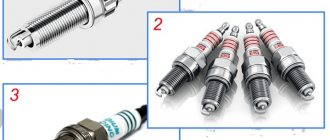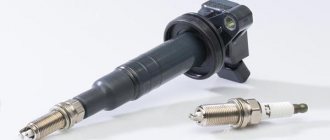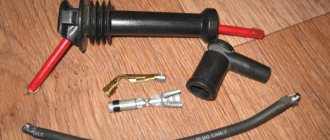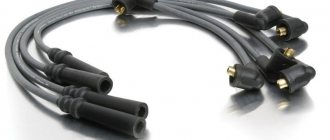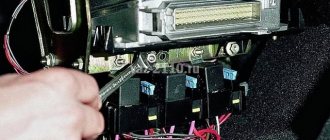After numerous experiments and failures, all designers of automobile gasoline engines settled on the spark method of igniting the working mixture. For more than a hundred years, this principle has not changed; only its components are improved. One of them is a spark plug, which directly forms a plasma discharge in a mixture of gasoline and air, which is under high pressure at the end of the compression stroke. Working conditions are difficult, demands on devices are constantly increasing.
Purpose of spark plugs
The spark plug is designed to convert the energy of a high-voltage electrical pulse generated by the ignition coil into hot plasma - a clot of ionized gas between the electrodes.
The temperature here is measured in thousands of degrees, which ensures uninterrupted ignition of the compressed combustible mixture.
This is interesting: Why one or two cylinders may not work
In addition, the part must comply with its other functions:
- reliably seal the threaded spark plug hole in the material of the block head that forms the combustion chamber;
- withstand extreme temperatures and pressures that arise during the combustion of the mixture during the working stroke of the piston;
- have a strictly defined temperature during operation, going beyond the permitted range is fraught with both the formation of soot and soot at its low value, as well as glow ignition or destruction due to overheating;
- have the property of self-cleaning during operation in the environment of burning hydrocarbons of gasoline and motor oil;
- maintain the established operating time, being subjected to electrical erosion and shock loads;
- Prevent leakage of high voltage currents to the engine ground.
At the same time, the spark plug, being a consumable, that is, a part with scheduled replacement, should not be expensive or create problems during engine maintenance operations.
Signs of faulty spark plugs
Spark plugs are an important part of any gasoline engine, however, like any other part, they are also subject to wear.
- Poor engine starting.
- Increased fuel consumption.
- Reduced engine power.
- Unstable engine operation.
However, it is worth remembering that the above malfunctions can indicate not only a problem in the spark plugs, but also about breakdowns in other systems. To do this, you need to remove them and inspect them. Let's look at how to replace spark plugs with your own hands .
Replacing spark plugs in car services in Moscow:
Loading car services...
+7 Metro station: Altufyevo
"MIKA", Moscow, st. Lobnenskaya, house 17
Enroll now
Location
The spark plugs are screwed along the threads of their body into the block head. The exact location in the combustion chamber is determined by considerations of optimal ignition, but in civilian vehicles, layout considerations are primarily taken into account.
Therefore, the established scheme is that on four-valve cylinders the spark plugs are placed vertically in the camber of the intake and exhaust valves in the center of the combustion chamber. With a single-row valve arrangement, the housing is screwed in from the side at an angle, directly adjacent to the incoming fuel from the intake valve.
Unscrewing the glow plugs.
#1 OFFLINE sol-d
UsersMessages: 4
Good afternoon everyone.
I have owned a car with a 606 three-liter turbodiesel for a long time and periodically have to change the glow plugs. Everything was fine until a certain moment, when they once again unscrewed the glow plugs, one of them broke off and remained in the engine. Then everything was like in a nightmare, instead of the hour-long procedure of replacing spark plugs, I removed the head and sent it for repairs to a special center where they drilled out the remains of the spark plug, etc. The amount of repairs was unpleasant, plus the car was down for three days. More than two years have passed since that incident, but recently a pair of spark plugs burned out again, the master who changed the spark plugs said: that I was very lucky, a pair of burnt-out spark plugs unscrewed, the rest, as he said, could not be unscrewed.
My question is the following: What do you recommend in this case? I really don't want to take the engine apart again. Maybe you can tell me from experience what are the ways to remove stuck candles.
Post edited by sol-d: January 18, 2010 - 23:23
- Top
#2 OFFLINE Driksel
Mersovody
Messages: 743
- City: St. Petersburg
There is a special non-stick lubricant for glow plugs, it costs much less than the above listed procedures with a motor.
MB123 200 Stromberg 1981/6 MB124 230E 1986/1993 MB123 200D 1980/9 favorite MB190D 2.0 1984/4 MB190D 2.5 1987/10 MB190 200E 1992/3/5 MB190 2.0E 19 92/9/10 MB124 E250D 1993/11 was probably the last one i30 1.6 (126hp) NEW SsangYong Actyon (149hp) NEW tractor
- Top
#3 OFFLINE Driksel
Mersovody
Messages: 743
- City: St. Petersburg
something like “High-temperature non-stick composition Copaslip” and spark plug changers need to be screwed if they are wrapped without, this is generally provided for in the technological map for this procedure. For some reason, the bourgeoisie does this by itself, without kicks or reminders, and they usually take less money for this than our “Kulibins”
Post edited by Driksel: January 19, 2010 - 11:26
MB123 200 Stromberg 1981/6 MB124 230E 1986/1993 MB123 200D 1980/9 favorite MB190D 2.0 1984/4 MB190D 2.5 1987/10 MB190 200E 1992/3/5 MB190 2.0E 19 92/9/10 MB124 E250D 1993/11 was probably the last one i30 1.6 (126hp) NEW SsangYong Actyon (149hp) NEW tractor
- Top
#4 OFFLINE Glebka87
UsersMessages: 37
I completely understand the author of this topic, I had the same thing. Now I lubricate it with a special lubricant and no problems. In general, I know that there is some kind of technology for unscrewing spark plugs without breaking them, well, in Merc centers, but I don’t know what they do.
- Top
#5 OFFLINE Daimler Benz 300D
Mersovody
Messages: 618
- City: Simferopol
- Car: W123T, W201, LP813
I have owned a car with a 606 three-liter turbodiesel for a long time and periodically have to change the glow plugs. Everything was fine until a certain moment, when they once again unscrewed the glow plugs, one of them broke off and remained in the engine. Then everything was like in a nightmare, instead of the hour-long procedure of replacing spark plugs, I removed the head and sent it for repairs to a special center where they drilled out the remains of the spark plug, etc. The amount of repairs was unpleasant, plus the car was down for three days. More than two years have passed since that incident, but recently a pair of spark plugs burned out again, the master who changed the spark plugs said: that I was very lucky, a pair of burnt-out spark plugs unscrewed, the rest, as he said, could not be unscrewed.
My question is the following: What do you recommend in this case? I really don't want to take the engine apart again. Maybe you can tell me from experience what are the ways to remove stuck candles.
I would pour WD 40 for 3 days, then heat up the engine (it expands) and cool the spark plugs with ice (they shrink) and unscrew it, so yesterday I took off the plug under the shade and removed it.
W123 300TD 5 manual transmission 1985 LP 813 5 manual transmission 1980 W123 TD 1985 Automatic transmission - FOR SALE W190 2.5D Turbo Diesel 1992. 5 manual transmission - FOR SALE 89782126990
- Top
#6 OFFLINE Igorek508
Mersovody
Messages: 190
- Rostov-on-Don
I completely understand the author of this topic, I had the same thing. Now I lubricate it with a special lubricant and no problems. In general, I know that there is some kind of technology for unscrewing spark plugs without breaking them, well, in Merc centers, but I don’t know what they do.
- Top
#7 OFFLINE mouse733
Mersovody
Messages: 1,377
- City: Ivanovo
- Car: S124 300 TD
about wrapping, everything was written correctly above, lubrication is required, but regarding such frequent combustion, this is unhealthy. Perhaps the nozzles are faulty or when wrapping the spark plugs they are overtightened
S 124 300TD WDB1241931F246156 603.960 VAZ 21214 W 124 300D WDB1241311C161649 606.910
- Top
#8 OFFLINE kaban yanyk
Mersovody
Messages: 392
- City: MO. Nikolina Gora
- Car: W126
the old-fashioned way, if it’s rusty or stuck: take vinegar (concentrate), wrap a rag soaked in it around the part, wait, then unscrew it.
w126 1989 WDB1260241A500201 sold in Stary Oskol Pontiac Trans Sport 1993
- Top
#9 OFFLINE timvod
UsersMessages: 41
- City: St. Petersburg
Don't mess with the spark plugs on 604-605-606, the intake manifold must be removed. I will be very grateful to the coordinates of a master in St. Petersburg who is competently able to change the spark plugs on the 605 and 606 engines; my friend and I burned out on 124 and 210 just in time for the Epiphany frosts
Device
The candle consists of several functional parts:
- housings with threads, faces for a spark plug wrench and a sealing metal gasket or cone;
- an insulator covering the central electrode in the lower part, and the contact rod in the upper part;
- pairs of electrodes, the central one in the insulator, the side curved one welded to the lower threaded part of the housing;
- interference suppression resistance in the upper part of the insulator;
- linings made of noble metals on electrodes in the spark gap zone to improve properties and extend service life.
Breakdown occurs in the spark gap zone. To normalize it, the gap size is normalized; it can change when the electrodes burn. Sometimes it is permissible to correct the gap by bending the side electrode.
Drilling and unscrewing
If the first two methods do not help, you will need to remove the cylinder head cover and drill a hole in the spark plug holder. A special sleeve of the appropriate diameter is screwed into it, having either a hexagonal notch or a thread on the inside. This operation cannot be carried out on the engine, since there is a high risk of chips and metal dust getting into the working area of the cylinder.
It is better to take the cylinder head cover to a turning workshop, where the hole and installation of the “screw plug” will be done as carefully and accurately as possible, without damaging the thread. In any case, disassembling the cylinder head can serve as an excellent reason for routine repairs of the gas distribution mechanism, piston system and replacement of gaskets.
Types and markings
Candles for widespread use can be classified according to several criteria:
- heat number - the ability to maintain the operating temperature of the insulator within specified limits; spark plugs are usually divided into hot and cold, depending on its value;
- the size of the working gap, sometimes one model has different gaps between the electrodes, depending on the orientation to a particular engine;
- geometric characteristics - length of the threaded part of the body, type of thread, wrench size, electrode protrusion;
- quality and service life are determined mainly by the metals used in the working gap, these can be copper, nickel, platinum, iridium;
- resistance of the noise suppression resistor;
- type of seal, gasket or cone.
Usually, the designation of a candle encodes its main parameters. But there is no single system; each manufacturer has its own symbols.
Even the heat value can increase or decrease with increasing or decreasing digital index. Therefore, it makes no sense to take this data into account.
When choosing, you should focus solely on the factory catalog number of the engine manufacturer (OEM). Sometimes the recommended designation of the manufacturer of ignition devices is also indicated there. Or a search is carried out using crossnumbers - OEM analogues in company catalogs.
For these reasons, part manufacturers are moving away from performance coding. It’s easier to indicate the crossnumber and a link to the OEM of different automobile companies.
Using a Spline or Torx bit
The easiest and least expensive way to unscrew a broken spark plug on a VAZ is to sacrifice a curly bat in the shape of an “asterisk”. To remove the spark plug you will need a Torx, Spline or other similar socket with a size of 12 mm. You need to put an extension on the bat and with a few precise blows drive it two or three millimeters into the neck of the clip stuck in the block.
It is better to pre-treat the candle with quick-acting lubricant or pour kerosene into the groove of the lid and leave it for a day. Unscrewing a broken spark plug is done using a ratchet handle counterclockwise. This method is suitable for candles that have broken off due to defects, but they are unlikely to be able to unscrew tightly tightened candles.
How to check spark plugs for functionality
Expensive candle models are usually subject to verification. Cheap devices are replaced as a set with new ones at the slightest doubt or if there is information about mileage over 5-10 thousand kilometers. The risk is too great, but the price is reasonable.
First of all, the condition of the insulator is assessed visually. It should be white with a slight brown tint. At a minimum, a dirty spark plug will have to be cleaned.
The condition of the electrodes and the gap size are checked (with a probe). When the metal wears out, the kit is replaced. The insulator must not have cracks or chips.
The only accurate control method is on a candle stand. In its transparent chamber, a pressure of over ten atmospheres is created, depending on the engine, after which a high-voltage discharge is formed with a maximum frequency.
Sparking must be stable and not extend beyond the spark gap. If the pressure is low, there is no point in checking the spark plugs.
What are the signs about church candles?
If you lit a church candle in your home and it began to crackle, it means you have a lot of negative energy in your home.
If the candle cracks in another place, it means that there is a person next to you who wishes you harm.
If you light a candle for health and the candle goes out, it means the person for whom you light the candle has serious health problems.
If you light it for the deceased and the candle also goes out, it means that the person to whom you light this candle is very offended by you.
If a candle drips, it means the person is damaged or has the evil eye.
If the candle breaks, then the person will have big problems. Problems can be both financial and health.
If a wedding candle breaks, it means there will be quarrels, fights, and betrayals in the family. Perhaps even a divorce.
How often do you need to change spark plugs?
The frequency of replacement is indicated in the vehicle manual. Typically, copper-nickel devices are changed at every maintenance, that is, 10-15 thousand kilometers, and platinum and iridium last about 60 thousand.
It is impossible to extend the timing, this is fraught with breakdown of the ignition coils due to the increased voltage when a large gap breaks down. Candles that are damaged due to engine problems, burnt or heavily sooted must also be replaced.
The thread tightening torque must not be exceeded. The housings break easily, if not immediately, then during a subsequent attempt to unscrew the tightened part.
Deviations from the normal combustion process
The working life of the spark plug may be reduced if the combustion process of the air-fuel mixture changes. This process is influenced by various factors, for example, poor fuel quality, early or late ignition, etc. Here are some of these factors that shorten the life of new spark plugs.
Misfire
This effect occurs when a lean mixture is supplied (much more air than fuel itself), when insufficient current power is generated (this occurs due to a malfunction of the ignition coil or due to poor-quality insulation of high-voltage wires - they are punctured) or when a spark misfire occurs. If the motor suffers from this malfunction, carbon deposits will form on the electrodes and insulator.
Glow ignition
There are two types of glow ignition: premature and retarded. In the first case, the spark fires before the piston reaches top dead center (the ignition timing increases). At this moment, the motor becomes very hot, which leads to an even greater increase in the SOP.
This effect leads to the fact that the air-fuel mixture can ignite randomly when entering the cylinder (it ignites due to the hot parts of the cylinder-piston group). When glow ignition occurs, valves, pistons, head gaskets and piston rings can be damaged. As for damage to the spark plug, in this case the insulator or electrodes may melt.
Detonation
This is a process that also occurs due to the high temperature in the cylinder and the low octane number of the fuel. During detonation, the not yet compressed VTS begins to ignite from a hot part in the part of the cylinder furthest from the intake piston. This process is accompanied by a sudden ignition of the air-fuel mixture. The released energy does not spread from the head of the block, but from the piston to the head at a speed exceeding the speed of sound.
As a result of detonation, the cylinder overheats greatly in one part, the pistons, valves and spark plugs themselves overheat. Plus the spark plug experiences increased pressure. As a result of such a process, the SZ insulator may burst or part of it may break off. The electrodes themselves may burn out or melt.
Engine detonation is determined by characteristic metallic knocks. Also, black smoke may appear from the exhaust pipe, the engine will begin to consume a lot of fuel, and its power will become noticeably less. To ensure timely detection of this destructive effect, a knock sensor is installed in modern engines.
Dieseling
Although this problem is not related to incorrect operation of the spark plugs, it still affects them, subjecting them to heavy load. Dieseling is the spontaneous ignition of gasoline when the engine is turned off. This effect occurs due to contact of the air-fuel mixture with hot engine parts.
This effect appears only in those power units in which the fuel system does not stop working when the ignition is turned off - in carburetor internal combustion engines. When the driver turns off the engine, by inertia the pistons continue to suck in the air-fuel mixture, and the mechanical fuel pump does not stop supplying gasoline to the carburetor.
Dieseling occurs at extremely low engine speeds, which is accompanied by very unstable engine operation. This effect stops when the parts of the cylinder-piston group do not cool sufficiently. In some cases this lasts a few seconds.
Carbon deposits on the candle
The type of carbon deposits on candles can be very different. It can be used to conditionally determine some problems with the engine. Solid carbon deposits appear on the surface of the electrodes when the temperature of the burning mixture exceeds 200 degrees.
If there is a lot of carbon on the spark plug, in most cases it prevents the performance of the spark plug. The problem can be resolved by cleaning the spark plug. But cleaning does not eliminate the cause of the formation of unnatural deposits, so these causes still need to be eliminated. Modern candles are designed so that they can clean themselves of carbon deposits.
Removing old spark plugs
The spark plugs themselves are connected to the block that distributes the ignition by wires that need to be disconnected. To do this, grab its cap and pull with slight force until the wire is disconnected. Remove the wire from only one spark plug to avoid getting tangled, since they are connected by special connectors that cannot be mixed up when connecting. Put the spark plug attachment on the key, secure it on top of the element and twist it counterclockwise. After removing the candle, you need to clean the dirt from the place where it stood. To do this, you will need a rag soaked in industrial alcohol.
Be sure to inspect the spark plug electrodes. Make sure that the space between them is not clogged with dirt. Possible problems with the rings are indicated by an excessive amount of oil on the spark plug. In this case, it is a good idea to show the car to a mechanic. If the old spark plug has a brownish tint, there are no problems with the engine.
How to unscrew a destroyed SZ
There are often situations when unsuccessful attempts to unscrew the SZ end in failure - the failure of part of it. However, even this development of the situation is not yet a tragedy. It is quite possible to unscrew a broken SZ. For this purpose, a special key is purchased in the store - an extractor.
Armed with the necessary tools, start unscrewing:
- clean the work site and fill it with WD-40;
- screw the extractor into the fragment;
- attach the extractor to a torque wrench and try to carefully unscrew the SZ;
- creaking and crackling are normal phenomena, signaling that the candle has “gone”;
- you need to turn slowly, without sudden movements and excessive efforts, so as not to break the thread;
- After removal, clean the spark plug well from debris and check the integrity of the threads.
This operation is quite risky due to the high probability of thread damage. Its failure is fraught with further replacement of the cylinder head or regrinding it for a special adapter insert. However, since further operation of the car is impossible with a broken SZ, even such a risk becomes justified.
Buy new spare parts on time and do not forget to monitor the health of your car!
Preparing to replace spark plugs
For those who have never changed spark plugs, it will not hurt to know that there is nothing complicated in this procedure - the main thing is to do it carefully, in the correct order of actions.
The first step is to find candles. On engines with four cylinders they are usually located on one side of the internal combustion engine or on top, in V8 engines - on the side so that there is one spark plug for each cylinder. When looking for spark plugs, look for wires surrounded by black insulation. Once you find them, you will easily find what you are looking for.
The next step will be preparing the necessary tools. Prepare a car key with a special attachment for working with spark plugs and a couple of new ignition elements. To make the job easier, take a can of compressed air, a rag and technical alcohol. If in the future you do not want problems with unscrewing the spark plugs at the next replacement, apply a little aerosol lubricant to the threads before screwing in the spark plugs.
To prevent dirt from penetrating inside the cylinder, it must be removed before removing the old spark plug, so clean the engine near the ignition element before starting the procedure. Debris and dust are removed using compressed air, which makes cleaning much easier. If there is a lot of dirt, use a rag soaked in industrial alcohol.
Useful tips
- Replace a complete set of spark plugs each time.
- Take your car to a car wash before replacing it. Or wash it at home using special cleaning products. This way you minimize the entry of dirt into the engine cylinders.
- Replacement of high-voltage wires must also be carried out completely. This means replacing the entire set.
- High-quality spark plug connectors are equipped with rubber seals, which facilitates good fixation of the spark plug.
This is how the spark plug contacts are adjusted

